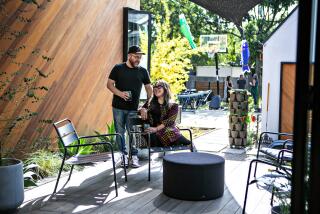Adohr Tale: A Window on the Past
- Share via
To young families starting out in a sprawling new kind of city that had just made its decisive turn into the automobile age, they were more than a mere convenience.
They were heroes; the emerging consumer society’s equivalent of the Three Musketeers: the Helms man, the milkman and the Good Humor man.
By the late 1930s, Los Angeles was sprawling outward in every direction, as family cars and new road networks brought cheap land and, therefore, homeownership within reach of an ever-growing number of people.
Supermarkets and other amenities, however, were slow to follow into the new suburbs. Many families still used wooden iceboxes, where milk and butter could not be stored for long.
So enterprising local companies used the same rubber tires that carried commuters to and from the new neighborhoods to bring customers a daily ration of those staples of the good, or any, life: bread, milk--and a little ice cream for dessert.
The Helms man and his mobile bakery have vanished, of course. So has the Good Humor man, though similarly melodious trucks still make their rounds in many neighborhoods, where ice cream vendors are a sweet reminder of home to many new immigrants. Few people, however, realize that milkmen in their starched white uniforms still ply their predawn trade in a few of the city’s enclaves.
In those earlier years, though, milkmen from dozens of dairies--Swan, Supreme, Excelsior, Crown City, Carnation, Driftwood and Alta Dena--blanketed Southern California, trailing puddles of water from blocks of ice that kept their farm-fresh products cold. But it was the giants like Adohr Farms that had hundreds of routes and that people in the new suburbs depended upon the most for special deliveries.
Despite rain, dogs and robbers, Adohr’s clean-cut milkmen delivered fresh dairy products daily to customers, who demonstrated their trust by leaving their kitchen doors unlocked.
One of Adohr’s outstanding employees was milkman Elmer Moss, who joined the company in the 1930s. For more than three decades, Moss made his way along a route that stretched from West Los Angeles’ flatland bungalows to mansions in Holmby Hills.
Moss’ extra services included bringing in newspapers, putting the milk into customers’ refrigerators and even moving the old milk upfront. He made sure houses were securely locked when customers went on vacation and always had a kind word for those home sick in bed.
Once Moss fixed breakfast for twin 7-year-old girls who had made a mess in the kitchen, while their mother was ill in bed. When Moss--his hair by then as white as his uniform--retired in the 1960s, residents of Holmby Hills honored him with a neighborhood party and a check for $1,030.55.
Though their service was very much a modern convenience, Moss and his colleagues worked for employers whose roots ran back to the city’s earliest days. In 1916, Merritt Huntley Adamson Sr. and his heiress wife, Rhoda Rindge Adamson, whose parents were the last owners of the vast Spanish land grant in Malibu, founded a state-of-the-art dairy in Tarzana called Adohr Farms; Adohr was Rhoda spelled backward.
A decade later, when Adohr’s famous reddish-golden brown Guernseys were known worldwide for their quality, size and productive capacity, the family opened a subsidiary--Adohr Creamery Co.--on a 20-acre parcel in what was then the country. The new plant processed and distributed the dairy products produced on the Tarzana farm. For more than 40 years, the company’s landmark, a fetching milkmaid, would stand with her cow and child, catching the eye of every passing motorist at La Cienega Boulevard and Sawyer Street.
The Depression plunged the family’s other operation, a beef ranch, into bankruptcy, forcing the Adamsons to sell most of their land to pay creditors. However, the dairy business kept the family solvent.
*
Adamson summers still were spent in a huge Spanish-style mansion on a 13-acre slice of beachfront, just east of Malibu Lagoon, that would become a showcase of colorful, locally produced ceramic tiles--one of the jewels of Southern California’s late Arts and Crafts era--and has since been converted into a local history museum.
In 1947, Adohr Farms moved from Tarzana to Camarillo, and two years later Adamson shot himself to death, apparently despondent over his failing health after a stroke.
After her husband’s death, Rhoda continued to sell off property to meet expenses. When she died in 1962, only about 4,000 acres of Malibu land remained out of the 17,000 acres of the Spanish land grant, title to which she and her siblings had inherited from their parents.
By 1966, the price of cattle feed had skyrocketed and the Adamson trustees were forced to sell Adohr Farms to the Southland Corp., which would change hands again more than two decades later. Making room for the Ward Plaza shopping center and the Westview Park subdivision, the dairy was torn down in 1969. The landmark milkmaid was saved from the bulldozer at the last minute, only to be abandoned by her new owners at one of their processing plants in Tulare County, where she still sits in disrepair.
More to Read
Inside the business of entertainment
The Wide Shot brings you news, analysis and insights on everything from streaming wars to production — and what it all means for the future.
You may occasionally receive promotional content from the Los Angeles Times.










